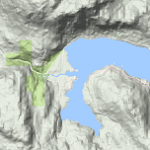 At Horne Lake, local people believed the trail went around the lake. Land agreements with the local Qualicum First Nation reflect this because the 1856 survey got lost.
At Horne Lake, local people believed the trail went around the lake. Land agreements with the local Qualicum First Nation reflect this because the 1856 survey got lost.
BUT the survey is exactly accurate for its time, points to the meaning of additional clues, and appears to be about to influence a treaty land claim – it shows that the passage does not go around the lake. The passage is the lake.
Later interpretations of memories of colonists (who used a pack-trail, and then a c1871-2 waggon road) caused the interpretation problem.
 It is fascinating that reproducible evidence – a faint squiggle on a 161-year-old survey might influence a modern treaty.
It is fascinating that reproducible evidence – a faint squiggle on a 161-year-old survey might influence a modern treaty.
Fascinating more, that this can be used to develop hypotheses which can be checked through archaeological testing. to look at the history of our common past and where we might go forward.
This is the power of reproducible evidence.